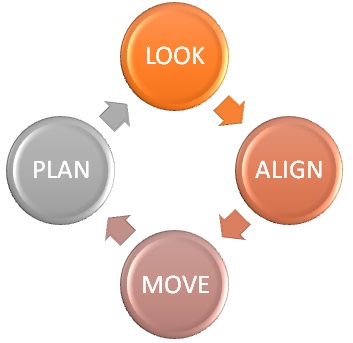A Coaching Model Created by Phyllis Lutchman
(Life Coach, TRINIDAD AND TOBAGO)

Be the light that helps others to see. Rumi
Rumi’s quote above is applicable to coaches. A coach lights the lamp of hope in the heart of the client. He lights the way for the client to see his path more clearly. In so doing, the client becomes more aware of any obstacles along his path to resolving his challenges. This self-awareness helps the client to think of ways that he can overcome his obstacles. He can then choose the one that he thinks is most suitable for him. The coach then invites him to formulate a plan of action that will assist him in overcoming his challenges. The client with the coach’s support implements his actions. The client also decides on his own method of accountability. The process is not a rigid one. The coach has to move along and support the client in whatever direction he takes. The coach must be able to “dance in the moment.” Coaching is helping the client to discover the answers himself. Galileo Galilei put it very nicely when he said
You cannot teach a man anything. You can only help him discover it within himself.
The LAMP model has (4) stages in the process.
Stage (1) – Look deep inside
Stage (2) – Align with your truth
Stage (3) – Move forward
Stage (4) – Plan your actions

Preparing to light the Lamp
A coach must prepare himself thoroughly before embarking on a session with his client. He must be curious and mindful. He must have acquired coach skills in areas such as powerful questioning ,powerful listening etc. He has to have a good working knowledge of framework and models such as Appreciative Inquiry,Emotional Intelligence,Neuro Linguistic Programming etc. so he can use them if necessary to assist the client to clarify his issues.He must also have Power Tools at his disposal(e.g respect vs.invalidation ,responding vs. reacting)that he can use to assist the client as he sees fit.He must function within ethical guidelines.
The coach must remember the following:
- The client is the focal point of the session. His wants and needs are paramount. The coach must establish trust and intimacy with the client for a successful outcome.
- The 80-20 rule. The client talks for 80% of the time and the coach 20% of the time.
- Only one question at a time must be asked. Time must be given to the client to digest and respond to before going to another question. The questions should be mainly open-ended.
- The coach must only guide the client in exploring his challenges. He must not advise him or give any solutions.
- The coach must not be judgmental. The ICF thinks that every client is creative, resourceful and whole.
- The coach must manage himself, so that he comes to each session in a positive frame of mind. He must be well balanced, relaxed having eaten and rested. If e.g. he is still grieving over the loss of a loved one, he should give himself time to regain his equilibrium before doing a session with a client.
- The coach must be confident,create awareness and give effective feedback.
- The environment for the session must be conducive to coaching. Distractions must be minimized. Calming artwork should be used. Comfortable chairs for both coach and client are essential.
Stage 1: Look deep inside
The coach invites the client to be involved in introspection. He is encouraged to clearly define his particular challenge. Powerful questioning, active listening and direct communication are essential at all stages of the process especially at the beginning. Some powerful questions that maybe useful at this stage are:
- What would you like to focus on today?
- What about this that is important to you?
- What is your main concern?
- What impact would this have on your life?
The coach has to be careful to understand the real challenge of the client. He has to listen to what he is saying as well as not saying. Sometimes, the issue that the client presents initially is not the real issue. The coach must invite the client to “look deep inside” to ascertain the real challenge.
The coach must also guide the client into thinking about what a successful outcome of their session would look like. Some useful questions can be:
- Where would you like to reach at the end of our time together?
- If we were successful today what would that look like?
- What do you want?
Establishing a Coaching Agreement is extremely important. It lays the foundation for transformational coaching to take place. The agreement is not rigid. If the client starts the session with one issue and moves to another, the coach has to move with the client. (After clarifying with the client that this new direction is where he wants to go.)
Visualization can be incorporated here to get the client to arrive at what a successful outcome of the session would look like.
Stage 2: Align with your truth
The coach must pay attention to the client’s values . For a successful outcome it is imperative that the goals selected by the client are aligned well with his values. Knowing his values and life purpose gives the client a clear direction to his life.It determines his choices.Some values are identified easily.Others need more discussion and thinking to be discovered. The Values Game is one exercise that can be useful at this point.Some useful questions are:
- What is most important to you in life?
- What makes you sad?
- What makes you angry?
In this stage the coach invites the client to look at his issue as it relates to how he sees the world. The client is also encouraged to determine his true intent. Meditation and deep breathing can be employed to relax the client. It can also assist in bringing information from the client’s subconscious mind about his underlying beliefs to his conscious mind.
By actively listening, asking powerful questions and communicating directly, the coach can assist the client in developing self-awareness. Self awareness leads to growth. Daniel Goleman in his famous book, “Emotional Intelligence” said that it is the “keystone” of emotional intelligence.It is a powerful tool to living a more fulfilled life.Some techniques that have been employed in the past by coaches to assist in this are:
- Encouraging the client to write in a journal everyday.
- Encouraging the client to list his strengths , weaknesses and goals.The Strengths Finder can be useful here if he is unclear of his strengths.
- Giving effective feedback on what the coach observed.
- Role play.
- The Wheel of Life exercise can help clients to become more aware of their work-life balance.
After a client becomes more self aware,exploration of aligning his challenge with his values and life purpose begin.
Some useful questions are:
- How is this working for you?
- How do you feel about this situation?
Stage 3: Move forward
At this stage the coach works together with the client to discover what is holding him back from moving forward. Some useful questions are:
- Are you ready to move forward?
- What is keeping you from moving forward?
When the client indicates that he is ready to move forward they can embark on exploration. Together they can explore different options to resolving the issue. An example of a good question at this point could be :
What ideas do you have that might work here?
Sometimes what is necessary is for the client to reframe his perspectives on the matter. Reframing helps others to see things differently. Very often a new perspective on an issue can go a long way towards its resolution.The coach can help the client to identify unhelpful perspectives by simply listening to him.This can provide a space for the client do explore his perspectives.He can then support him in reframing them.
The client may also have to be more committed to resolving the issue rather than just “trying.” The Power tool of Commitment vs. Trying would be especially useful here.In some cases encouraging the client to accept a particular situation that he cannot change is what is needed.Encouraging the client to be grateful for what he has can also help him to move forward.Keeping a Gratitude Journal is one way this can be achieved.Procrastination also prevents clients from moving on.Strategic questioning by the coach can empower the client to move forward.Some clients need to be motivated by case studies ,metaphors and analogies to move forward.
Stage 4: Plan your actions
At this stage the coach works with the client to assist him in designing what actions he needs to take to move forward. Brainstorming can be useful here. When actions are aligned with goals there is greater commitment. The client is encouraged to make his actions specific, measurable, realistic and have stated dates for completion.
They also discuss what support, resources and structures the client might need in order to implement the plan of action that was created. Some good questions are :
- What support do you need?
- Who can provide this support?
- What resources do you need?
- What structures can you put in place to help you achieve your goal?
The coach and client then discuss what could possibly hinder the client from achieving his outcome. They discuss also ways that any obstacles maybe overcome. The coach also partners with the client to design methods of accountability that are best suited to the client.
The coach encourages the client to reflect on what he will take away from the session.
Keeping the lamp burning:
The coach must always leave some space between clients. This will enable him to be in the right frame of mind to receive his new client. He must not carry the emotional baggage from the prior session to the new client.There are many effective methods that have been used to assist the coach in maintaining his balance. Meditation and listening to soft, soothing music are popular. Simply sitting in silence can also achieve this. How well a coach is able to accomplish this, will impact on his effectiveness as a coach.

The lamp burns bright when wick and oil are clean. Ovid
<<Find out more about how to create your own Coaching model at ICA>>